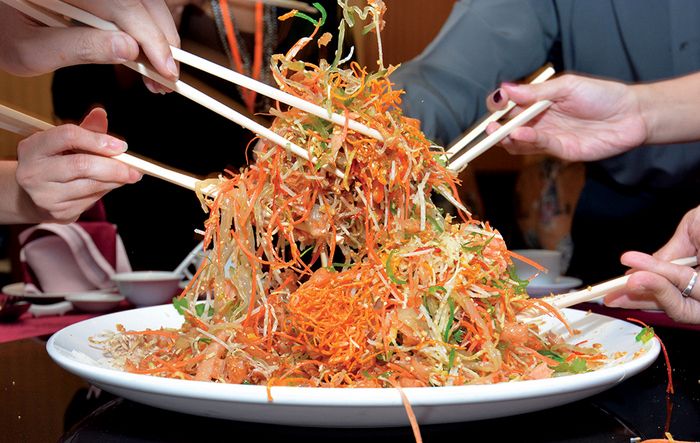Value of Yee Sang


Connexion
By Joachim Ng
The FOG Diet is clogging up our body’s internal drainage systems. Fat, Oil, and Grease. Excessive intake of fatty meats, recycled cooking oil favoured by many eateries, and frying pan grease is one reason for your tummy bulge and the frequent ailments besetting you.
Do a yearly flush, and the season for it has begun. With excitement building up towards Chinese New Year, many restaurants have already put on display the famous therapeutic dish — Yee Sang.
The celebration gets off to an early start in Perak as legend has it that this cleansing raw fish salad (yee sang means raw fish) platter in its modern form has a local Cantonese origin. The stamp of Ipoh is clearly on this heritage dish, as will be seen later when we discuss a fruity ingredient.
Why is yee sang therapeutic? The fish is either salmon or jellyfish. Salmon has only 13% fat content and jellyfish is even better at just 1.4% fat content. As the fish is eaten raw, there is no cooking oil and grease. You un-FOG your body. Make sure the fish is commercially frozen and hence worm-free.
However, raw fish is a barely visible component although the dish is named after it. The bulk is taken up by a variety of nourishing plant foods, again fresh and uncooked. Yee sang’s mix of vegetarian ingredients with slices of non-fatty fish makes it a natural detoxifier.
Topping the list of body-cleansing plant elements is none other than Ipoh’s juicy prince of fruits, the pomelo. Light yellowish in colour, the pomelo is enriched by spring water from the limestone hills of Tambun and contains antioxidant heart-strengthening minerals in abundance such as potassium. Come to Ipoh for yee sang with pomelo right where it’s grown: this is a succulent prince in waiting, as the pricey musang king goes on a rewarding extended journey overseas.
Next is a flourishing mix of colours — red carrots, green and white radish, sesame seeds and ground peanuts, pepper, and a lacing of sesame oil, peanut oil and plum sauce. It’s sufficient to empty just half of these oil and sauce packets into the dish to lubricate the mixture. You may also add nangka (jackfruit).
Couldn’t you have yee sang every day from the start of 2018 and throughout the 15 wonderful days of Chinese New Year? You could, if you replicate the social setting each time. Yee sang isn’t just about food; it’s about togetherness in health and prosperity. Yee sang is never eaten alone but traditionally in a group forming a perfect circle at a round table signifying unbroken unity. Eating a healthy meal in such a joyful circle confers another great benefit — social happiness that relieves work stress. You could in fact purchase yee sang ingredients from a supermarket, cut them up in the office pantry, and lo hei (toss up good fortune) amidst the laptops.
The mouth-watering yee sang has long taken on a life beyond cultural borders uniting Malaysians of all communities in a nourishing expression of friendship. Over decades yee sang has served as a culinary bond igniting team spirit, as business partners and office colleagues stand together to lo hei.
The yee sang longevity formula is worth remembering: a fruit-veggie meal with some raw (or steamed) fish plus loads of happiness that sprout from your web of beneficial social connections. Be sure to observe the ritual of standing together, tossing up the food in unison, and shouting out your best wishes. Together we are Malaysia, and let’s keep our multicultural friendships ever fresh like the yee sang.


